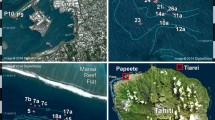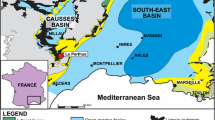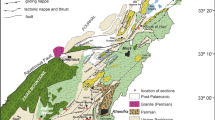Abstract
The Gran Banco de Buena Esperanza (GBBE) coral reef system in Golfo de Guacanayabo in southeastern Cuba consists of a reticular structure comprising a maze of steep to vertical ridges with planar tops rising 20–25 m from the bay floor. The planar tops of the ridges are densely populated by small colonies of sediment-resistant Scleractinia with fragile, branching colony growth forms. The initiation of a reticulate reef system in the absence of karst or other antecedent hard substrates is unprecedented. In this note, we describe the unique geological setting, geomorphology and scleractinian diversity of the GBBE and present an explanation for its development. We suggest that convection-driven self-organization of coral skeletal fragments may be responsible for the reticulate pattern observed as 75 m of reef limestone accreted during Holocene time. Finally, we briefly discuss the evolutionary benefits of coral hybridization and the potential for rapid coral reef growth in turbid, muddy environments.



Similar content being viewed by others
References
Avello Suárez O, Pavlidis YA (1986) Sedimentos de la plataforma cubana. II. Golfos de Anna María y Guacanayabo. Rep Invest Inst Geol y Paleont Acad Cien Cuba No 6:1–27
Ball P (1999) The self-made tapestry: patterns in nature. Oxford University Press, Oxford
Ball P (2016) Patterns in nature: why natural world looks the way it does. The University of Chicago Press, Chicago
Blakeway D (2018) Hypoxia shapes coral reefs. PeerJ Preprints 6:e26794v1. https://doi.org/10.7287/peerj.preprints.26794v1
Cabrera Castellanos M, Batista González R (2009) Naturaleza geológica del territorio marino-costero de Cuba en el Cuaternario. Centro Nacional de Información Geológica, IGP Cuba ISBN 978-959-7117 17-9
Gonzáles Ferrer S (2004) Corales pétreos, jardines sumergidos de Cuba. Editorial Academia, La Habana
Hernández-Fernández L, Olivera Y, González-De Zayas R, Salvat Torres H, Guimarais Bermejo M, Ventura Díaz Y, Pina-Amargós F (2013) Caracterización fisicoquímica e inventario de especies del Gran Banco de Buena Esperanza, golfo de Guacanayabo, Cuba. Rev Invest Mar 33(2):43–57
Ionin AS, Pavlidis YA, Avello Suárez O (1977) Geology of Cuban shelf. Nauka, Moscow (in Russian)
Kemp M (2016) Structural intuitions: seeing shapes in art and science. University of Virginia Press, Charlottesville
Kidwell SM (1983) Taphonomic feedback in Miocene assemblages: testing the role of dead hardparts in benthic communities. Palaios 1(3):239–255
Neumann AC, MacIntyre IG (1985) Reef response to sea level rise: keep-up, catch-up or give-up, p. 105-110 In: Gabrie C, Toffart JL, Salvat BS (eds) Proceedings of The Fifth International Coral Reef Congress. Tahiti, 27 May–1 June 1985. Vol. 3: Symposia and Seminars (A)
Pardo Echarte ME, Cobiella Reguera JL (2017) Overview of the geology of Cuba Oil and gas exploration in Cuba. SpringerBriefs in Earth System Sciences. https://doi.org/10.1007/978-3-319-56744-0_2
Precht WP, Vollmer SV, Modys AB, Kaufman L (2019) Fossil Acropora prolifera (Lamarck, 1816) reveals coral hybridizations is not only a recent phenomenon. Proc Biol Soc Wash 132:40–55
Purkis S, Casini G, Hunt D, Colpaert A (2015) Morphometric patterns in Modern carbonate platforms can be applied to the ancient rock record: similarities between Modern Alacranes reef and Upper Palaeozoic platforms of the Barents Sea. Sedimentary Geology 321:49–69
Purkis S, van de Koppel J, Burgess PM (2016) Spatial self-organization in carbonate depositional environments. In: Budd DA, Hayek EA, Purkis SJ (eds) Autogenic dynamics and self-organization in sedimentary systems. SEPM Special Publication 106, Tulsa, Oklahoma, pp 53–66
Schlager W, Purkis S (2015) Reticulate reef patterns—antecedent karst versus self-organization. Sedimentology 62:501–515
Spalding MD, Rivilious C, Green EP (2001) World atlas of coral reefs. University of California Press, Berkeley
Woodroffe CD (2011) Reticulated reefs. In: Hopley D (ed) Encyclopedia of modern coral reefs: structure, form and process. Springer, Berlin, pp 931–933
Zlatarski VN, Martinez Estalella N (1980) The scleractinians of Cuba with data of associated organisms. Editions de l’Académie bulgare des Science, Sofia (in Russian; 1982 in French; 2018 in Spanish, with Notes by author and editors, Harte Research Institute for Gulf of Mexico Studies at Texas A&M University-Corpus Christi)
Acknowledgements
Ms. J. Granatino of the Barrington Public Library in Rhode Island provided assistance in obtaining access to many publications. We benefited from discussion of the geological setting of the bay with Dr. M. Cabrera Castellanos and consultation with Dr. N. Fogarty concerning A. prolifera. The manuscript benefited a great deal from the suggestions of the Editor in Chief and the Topic Editor of Coral Reefs and the reviews of Dr. S. J. Purkis and Dr. D. Blakeway, to whom we also are grateful for drafting Fig. 2. Kevin O’Rourke (Center for Scholarship, Teaching and Technology, Roger Williams University) provided technical assistance with Fig. 3.
Author information
Authors and Affiliations
Corresponding author
Ethics declarations
Conflict of interest
The authors hereby declare that no conflict of interest exists.
Additional information
Topic Editor Mark R. Patterson
Publisher's Note
Springer Nature remains neutral with regard to jurisdictional claims in published maps and institutional affiliations.
Rights and permissions
About this article
Cite this article
Zlatarski, V.N., Greenstein, B.J. The reticulate coral reef system in Golfo de Guacanayabo, SE Cuba. Coral Reefs 39, 509–513 (2020). https://doi.org/10.1007/s00338-020-01933-7
Received:
Accepted:
Published:
Issue Date:
DOI: https://doi.org/10.1007/s00338-020-01933-7




